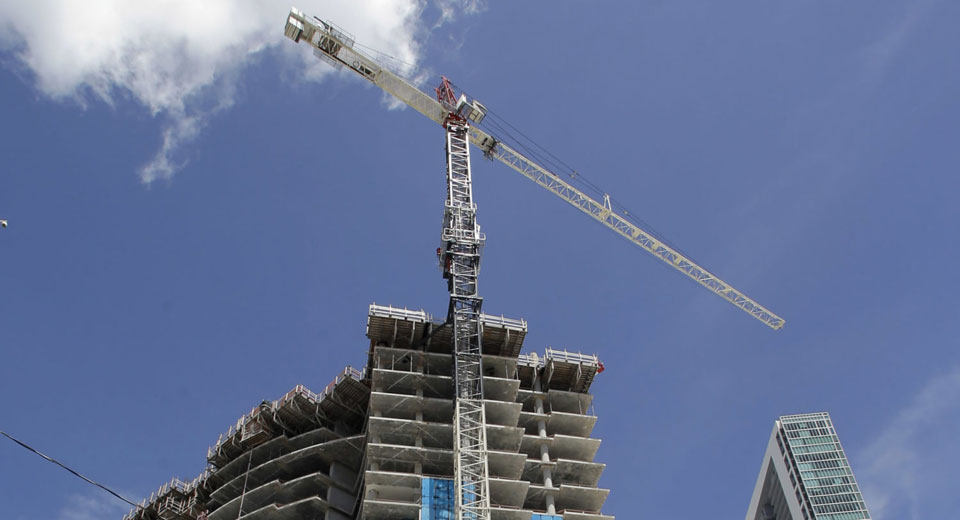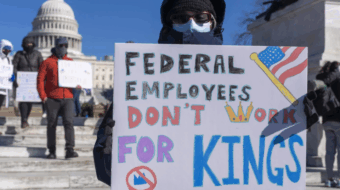
UPPER MARLBORO, Md. —Construction union leaders hailed President Joe Biden’s Feb. 7 executive order requiring that federally funded construction projects worth at least $35 million be built by unionists using Project Labor Agreements.
“Just remember, it ain’t labor—it’s unions” that built the country and will do so again, Biden declared to a union crowd at the Ironworkers Local 5 hall in Upper Marlboro, Md.
Sean McGarvey, president of North America’s Building Trades Unions, spoke for the others—including Local 5 members at Biden’s signing ceremony—in declaring how Biden’s order would improve workers’ wages, working conditions and health and safety.
“Project labor agreements are often effective in preventing problems from developing” on construction sites “because they provide structure and stability to large-scale construction projects,” Biden’s order explains.
That’s “welcome news for all workers, union and nonunion,” McGarvey pointed out. “Project Labor Agreements address labor supply, secure workers’ classification, set good wages, promote strong health and safety standards, and ensure large-scale projects are completed on time, with the highest degree of quality, efficiency, and safety.”
McGarvey added PLAs not only create well-paying jobs for construction workers, but promote local hiring, increase well-trained—union-trained—apprentices and can let “women, people of color and veterans access construction career pathways.
“As a result, these agreements are proven to boost local economies, address inequities and uplift marginalized communities, and achieve substantial, direct cost savings by standardizing contract terms among various crafts.”
Biden’s order stressed the benefits of PLAs. They “avoid disruptions on projects by using dispute-resolution processes to resolve worksite disputes and by prohibiting work stoppages, including strikes and lockouts. They secure commitment of all stakeholders on a construction site the project will proceed efficiently without unnecessary interruptions.”
In return for higher wages and guaranteed due process on the job to workers and contractors get stability and quality work that lasts, the president said at the ceremony. He did not estimate how many workers would directly benefit. One estimate was 200,000.
“I tell you who built America: The middle class,” he explained. “And the people who built the middle class are organized labor — unions. Unions did it,” he declared, to applause. “That’s not hyperbole. That’s a fact. That’s a straight fact.
Biden said his order will “help ensure we build a better America, we build it right, and we build it on time, and we build it cheaper than it would have been otherwise.
Done on time
“You know, the executive order is making sure federal construction projects get completed on time and under budget, saving taxpayers money, clearing construction zones quickly, and ensuring everything the federal government signs to contract to build is built to last.”
Biden’s order covers not just work on roads, bridges, subways and airports, but all types of infrastructure. He specifically singled out improving U.S. ports and waterways.
Such maritime improvements, in the “hard” infrastructure law Biden signed in December, include at least two which PLAs would cover, according to a recent statement from the AFL-CIO Maritime Trades Department: A new larger Soo Lock between Lake Superior and the other Great Lakes, costing $470 million, and $69 million “to improve navigation and expand capacity” at the Norfolk, Va., harbor, where container traffic has risen 67% in 10 years.
Biden’s order has some limited exceptions, but even when agencies want to invoke them to avoid PLAs, a “senior official” must sign off on that decision, and justify the exception.
The limited exceptions include projects of short duration, that use only one construction craft, that are “of compelling urgency that…makes a Project Labor Agreement impractical” or those where a PLA requirement would “substantially reduce the number of potential bidders so as to frustrate full and open competition.”
Numerous studies have pointed out the benefits of PLAs in the real world, disclosing how those projects come in on time and often under budget. That hasn’t stopped the ABC and its right-wing allies from trying to destroy unions and their workers’ wages, by outlawing PLAs.
NABTU and construction unions, working with lawmakers of both parties, have beaten back such moves in Congress. Given gridlock on Capitol Hill—on worker issues as well as everything else—Biden’s being proactive, instead. Union leaders and Rep. Donald Norcross, D-N.J., an Electrical Worker, applauded.
PLAs “standardize working conditions across a project and ensure that all working people receive fair wages, benefits, and safe working conditions,” Painters President Jimmy Williams Jr., said.
Biden’s order “will unquestionably raise standards within our industry” open up apprenticeships, aid workers “ in disadvantaged and marginalized communities, and improve the construction market by standardizing labor conditions.”
“PLAs were utilized when Operating Engineers built the Grand Coulee Dam, the interstate highway system,” and space facilities, added IUOE President James Callahan. “As we embark upon building modern and more resilient infrastructure for our future, these agreements will help employ thousands of skilled tradespeople and pay wages that sustain families and lift local economies.”
Biden’s order “shows what the American worker has to gain by having a pro-labor president in the White House,” said Norcross, who is also a former president of the South Jersey Building and Construction Trades Council. He provided the estimate.
“Requiring PLAs on federal construction projects will improve job quality for nearly 200,000 workers. PLAs also help ensure the responsible stewardship of tax dollars by pre-negotiating wages and benefits–meaning workers can spend more time working and less time haggling over work conditions. Additionally, workers under a PLA are more likely to have health care, a benefit that has always been important in demanding construction jobs but even more so during the pandemic.”










